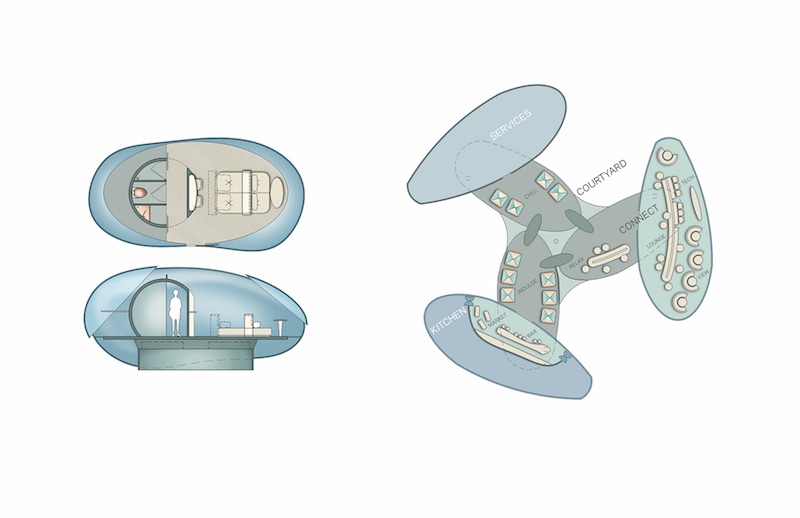There are only so many times a family can vacation to Disneyland before it grows a bit tiresome. The problem is, as jaded as it may seem, many vacation destinations fail to impress because they all provide similar experiences. But what if your next vacation could take a step off the well-worn path carved by thousands of travelers before you and, instead, become something completely tailored?
That’s the idea behind HOK’s Driftscape, a concept that combines hospitality with the technology of autonomous vehicles and drones. Driftscape uses modular glass units powered by long-range batteries to travel to locales previously uninhabitable by more traditional hotels, such as secluded tropical islands, mountaintops, and national parks.
Driftscape incorporates two components: the Oasis, which features operational and community units with a food and beverage element, and the Driftcraft, the actual guestroom.
Instead of the hotel room acting as the last stop on your journey, the Driftscape experience takes guests on what HOK designers call the “reverse journey.” The roaming guestroom collects the guests at a designated pick-up zone and then travels to their final destination, which will often be the Oasis and its myriad amenities set up in a remote, scenic location—all while leaving minimal impact on the environment, says HOK.
This all may sound a bit chimerical, but perhaps the most unbelievable aspect of Driftscape is its feasibility. “With the rapid advancements being made in the autonomous vehicle and drone industry by companies such as Tesla and Ehang, we estimate the possibility of this futuristic concept coming to fruition within five to seven years,” says Ian Rolston, LEED GA, Senior Project Interior Designer with HOK.
Initially, the Driftscape concept would be considered a premium experience and have a pricetag to match. But with the rapidly evolving technology, costs will eventually be akin to those of a luxury cruise, says Rolston.
 Rendering courtesy of HOK.
Rendering courtesy of HOK.
 Rendering courtesy of HOK.
Rendering courtesy of HOK.
Related Stories
Great Solutions | Apr 13, 2020
Family workstations highlight the new Fairfield Area Library
The workstations are the perfect remedy for squirming, restless children and toddlers.
Great Solutions | Feb 5, 2020
Power moves: The Shed
Precise positioning of mechanicals above its lighting keeps New York’s kinetic event space, The Shed, running.
Great Solutions | Dec 18, 2019
Robot uprising
Thyssenkrupp’s robotics interface platform helps robots use elevators like humans.
Great Solutions | Nov 12, 2019
Skanska designs personal protective equipment tailor-made for the female workforce
A safety vest is the first piece of equipment to undergo an update.
Great Solutions | Oct 3, 2019
REEF Technology wants to turn parking facilities into urban mobility hubs
The company currently operates 4,500 parking lots in 25 markets across North America.
Great Solutions | Aug 30, 2019
An ‘Internet of Beings’? Kinetic flooring promises more than just energy generation
Pavegen says its technology delivers a new level of human engagement in sustainability initiatives.
Great Solutions | Aug 7, 2019
Earthquake response system takes the guesswork out of seismic safety
The platform provides real-time monitoring to help avoid unnecessary evacuations and improve emergency response.
Great Solutions | Jul 12, 2019
Smart sensor maintains privacy, enhances safety in sensitive spaces
The HALO IOT sensor is designed for use in places where cameras are not welcome.
Great Solutions | Apr 9, 2019
Raising the roof is cool again
Upbrella allows for floor-by-floor building construction that is, reportedly, safer and more productive than traditional methods.
Great Solutions | Mar 12, 2019
When is wood not really wood?
Inspired by the look and cellular nature of wood, researchers create 3D-printed “digital wood” and “metallic wood” that is as strong as titanium, with the density of water.
















